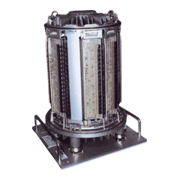Magnetic drums were widely used due to features such as a short average access time and a low error rate in recorded data. H-8575 was commercialized in 1975 as a magnetic drum unit for the HITAC M Series, with the aim of further shortening average access time and greatly improving capacity.
Average access time was halved to 5.3ms by doubling drum rotation speed from the previous 3,000rpm to 6,000rpm. Capacity was roughly quadrupled to 15MB (megabyte). This was achieved by taking measures to increase density, such as halving spacing between the floating head and media to approximately 1μm, and by increasing track density. Data transfer speed was also a high 12Mbit/s, and at the time, this magnetic drum had the best performance in the world.
This magnetic drum was a product developed through joint research by Nippon Telegraph and Telephone Public Corporation and Hitachi, Ltd., and it was also used in the data communication systems of Nippon Telegraph and Telephone Public Corporation.
| Unit model name | H-8575 | |
|---|---|---|
| Completion date | 1975 | |
| Head type | Floating head | |
| Head floating distance | 1.0 μm | |
| Memory capacity | 15 MB | |
| Recording system | NRZ-I recording system(8/9bit conversion) | |
| Average access time | 5.3 ms | |
| Data transfer speed | 12Mbit/s | |
| Drum | Name of unit used | FV-2540F |
| Number of tracks | 1,024 | |
| Rotation speed | 6,000 rpm | |
| Rotor dimensions | 250 ø×420 mm | |
| Recording density | 156 bit/mm | |
| Connected systems | Digital switching systems/DIPS/ Subscriber data communication systems Seat reservation systems HITAC-M Series |
|



